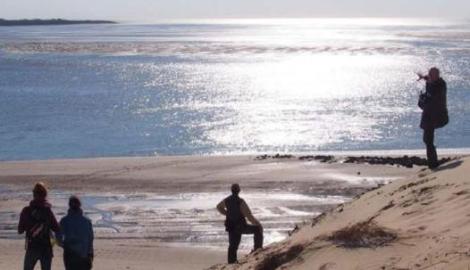Adapto and landscape
The landscape approach encourages us to reflect on the many ways of working with uncertainty
2022
Initiated by the Conservatoire du littoral, Adapto is a project that benefits from EU financial support through the LIFE programme. Adapto aims to explore solutions to erosion and marine submersion in natural coastal areas in the context of increasing climate change, which is manifested by rising sea levels and an increase in the frequency of extreme weather events. The landscape approach is an essential contribution, supporting sensitive perspectives and shared diagnoses, dialogue and prospective vision imagined and projects developed with the stakeholders of the territories concerned.
To download : livret_paysage_voir_2022.pdf (6.7 MiB)
The landscape, a new philosophy for the adaptation of the coastline
Climate change causes various phenomena on the sea shores, two of which are very significant: the rise in the average sea level and the increase in the intensity of storms. Sea level rose at a rate of 1.5 mm per year during the 20th century, but this has accelerated over the last decade to reach a rate of 3.5 mm/year. Even if the coastline has always been mobile, climate change and the attraction of the coastline for human populations are today leading to an increase in the risks associated with erosion and submersion.
The Conservatoire du littoral has been conducting studies for several decades on the impact of climate change on its land assets, and very early on took into account the need to adapt to the effects of climate change in its long-term strategy.
It has thus questioned the landscape approach and landscape designers in numerous studies on future attitudes to adopt in the face of rising sea levels in France. The Conservatoire and the landscape designers have come together around a change in the philosophy of action in the territories: to support the sites and the actors ‘to deal with the sea’ and not ‘against the sea’.
The partnership with the Ecole nationale supérieure de paysage on the adapto sites places the ‘shared foresight’ of the landscape as a key element of the adapto programme. Much more than a landscape planning strategy, it is a true landscape approach.

Coastal issues and the teaching of the great landscape
Large-scale territories have been taught at the School of Landscape Architecture since its creation. Very early on, as early as 1986, the Regional Educational Workshops (REW) initiated by Michel Corajoud (and the team at the time at the Le Nôtre workshop) were at the origin of exemplary experiments on a large scale in landscape architecture. A profession at the crossroads of urban planning, ecology and many other disciplines, the French landscape architect is today recognised for his vocation as a developer, for his capacity for multiscalar intervention and his approach to large-scale landscape planning.
The successive works carried out by landscape architects and the influence of the European Landscape Convention on the large-scale dimension have forged a particular culture of French coastal areas.
The problem of rising sea levels is a landscape issue par excellence. It is the expression of movement mixed with the complexity of the large territory. It is an alloy between the force of the relief, the metamorphoses of the living and the social and economic dynamics. Moreover, the hazard of flooding leads directly to the multidisciplinary dimension of the landscape, to questioning a diversity of actors and possible actions concerned with the coastal subject.
Most of the adapto sites were planned by our students during action research projects, workshops or final degree projects. This collection illustrates the diversity of these teachings and their effects on the territories.
The VOIR approach developed by Alain Freytet and Romain Quesada during the workshop supervision was a common thread for addressing the complexity of the wider landscape with methodology.
The younger generation: inclusive teaching to address risks
The landscape designer is a professional whose objective is to invent a more welcoming, lively and resilient world in every situation. This deliberately optimistic project-based approach is intrinsic to the profession.
Planning the future of an area while taking risks is a sensitive and delicate exercise, but the younger generation, who experience the environmental and societal crisis on a daily basis, cultivate this inherited positive attitude and are well placed to deal with the climate emergency.
On the adapto sites, the young designers have proven this by giving valuable time to listening to the stakeholders of the sites; by endeavouring to identify the strengths of a place before responding to a problem raised; or by capturing the dynamics of the sites to share a new story of the living world.
This ability to develop a new perspective on the landscape and coastline was shared in 2019 during the participatory day ‘Imagining the coastline of tomorrow’ organised by the coastal office of the then ministry. The ENSP presented the prospective visions of the adapto sites, combined with that of a daring workshop with Cerema on the Baie de Somme. The students discussed the urgent need for new forms of governance on coastal sites and the need for a collective awareness of a ‘laissez-faire’, ‘letting go’ approach that should be developed on certain sites in the face of rising waters, in the spirit of a festive ecology: a concept promoted by the landscape architect Alfred Peter.